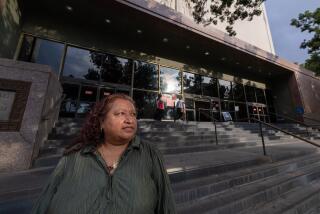Supervisors Seek to End Legal Fight Over Homeless Care
The new liberal majority on the Los Angeles County Board of Supervisors is pushing hard to settle the long-running legal battle over whether the county is doing enough to care for thousands of homeless people, a fight that has cost $4.1 million in legal fees.
Using money budgeted to help the poor, the county has paid private lawyers up to $325 an hour to fend off efforts by the Legal Aid Foundation and the city of Los Angeles to force an increase in welfare services to the homeless, officials report.
The decision to negotiate, rather than continue the fight, came after the board learned that the county was paying lawyers millions of dollars to block any raises in the $312-a-month basic welfare grant, and prevent other reforms in the $211-million-a-year general relief program.
Supervisors Ed Edelman and Kenneth Hahn, joined by newly elected Gloria Molina, voted in mid-March to order the county counsel to settle the lawsuits.
“Rather than fighting and spending $300 an hour on lawyers, we are now talking about how to make the system work better,” said Gerry Hertzberg, chief legislative aide to Molina. He called the money spent for private lawyers an “absolute travesty.”
At issue are several suits brought by Legal Aid and the city claiming that the county is not properly administering the general relief program, the main source of welfare assistance for the homeless in Los Angeles.
The county is deliberately and illegally denying aid to indigents through a cumbersome bureaucracy plagued by chronic understaffing and caught up in punitive red tape, the suits claim. Those who do receive aid do not get enough to survive, throwing the burden of care on the city, say advocates for the homeless.
“General relief is supposed to be a bridge to help people across a crisis,” said Gary Blasi, director Legal Aid’s Homeless Project. “But the county wants to throw the people off the bridge.”
County officials argue that the welfare department is doing its best to help the homeless, given slim budgets and growing welfare caseloads. Regulations exist to make sure that limited dollars go to those who are qualified, they say.
Supervisor Deane Dana, one of two conservatives on the five-member board, defended the previous policies. “When tens of millions are at stake, you have to get the very best.”
The three most controversial issues raised in the lawsuits are:
* Whether the county should increase the $312 general relief check by as much as $108, pushing monthly costs up $5 million. Most people who receive such relief are homeless.
* Whether the county has the right to halt aid for 60 days as a penalty for failing to pass a monthly test designed to detect cheating. On average, 10,500 cases are under penalty at any time, saving about $3 million a month, records show.
* Whether the county is doing enough to help mentally ill general relief clients transfer to federally funded programs for the handicapped, a move that could save the county millions.
While the issues are debated, thousands have nowhere to turn but the streets.
Recent studies report the number of homeless in Los Angeles is significantly higher than 150,000 during a year. Reports show one-third qualify for welfare’s general relief program, the safety net of last resort.
Visits to the noisy, crowded welfare office waiting rooms around the city reveal the human misery behind the statistics. Long lines of people extend outside and down the block. The destitute wait for hours to speak to a caseworker, only to be told to return another day.
On a recent rainy day, a tall, disheveled man paced the crowded waiting room in the Echo Park welfare office on Beverly Boulevard. Troubled and confused, he was broke and homeless. Papers in his hip pocket revealed that he had tried unsuccessfully to get help for three days.
Stamped at the top of the forms were the letters NSA, the welfare department’s designation for a mentally ill person who “needs special assistance.” Regulations require NSA cases to be handled immediately, but officials could not explain why he had not been helped.
Echo Park is an example of the problems faced by recipients and the county’s social workers who must contend with staff shortages, failing computers and heavy caseloads.
“Certainly it is true, (recipients) must wait a long time, even when they have appointments,” said Gerald Elijah, manager of the Echo Park office. “The staff simply doesn’t have the time to see them quickly. It’s a case of declining resources to meet a growing demand.”
Legal Aid and city officials contend that layers of restrictive regulations burden the system unnecessarily and keep the needy on the streets.
“They (county officials) aren’t saving any money. They’re just transferring the problem to the city and to private agencies,” said Assistant City Atty. Julie P. Downey.
The Legal Aid and city lawsuits were consolidated and are backed by the Los Angeles Bar Assn., the American Civil Liberties Union and other public interest groups.
The Board of Supervisors countered by hiring the firm of Parker, Milliken, Clark, O’Hara & Samuelian. Records made available by Legal Aid show that the $4.1 million paid to the firm came from either indigent aid accounts or the welfare administrative funds.
County officials confirmed the $4.1 million figure and said the firm’s billings ranged from $70 to $325 an hour, with the partner managing the county’s defense getting $250 an hour.
The law firm’s role is being scaled back and the county counsel is reclaiming control of the cases, said Deputy Counsel Counsel Roberta Fesler. She said the focus now is on resolving the controversy.
Any settlement will almost certainly increase the county’s costs.
“You are looking at potentially huge sums of money,” said Tom Silver, chief deputy to board Chairman Mike Antonovich. An aide to Dana estimated that the demands being made by Legal Aid and city would cost $60 million.
The 1990 general relief budget was $177 million, plus $34 million for administration. About 55,000 people receive monthly checks. The welfare department says it gets 15,000 new applications a month, but 45% do not qualify.
The toughest issues are the demands to increase the basic $312 monthly welfare grant and the elimination or modification of the 60-day penalty regulation.
Legal Aid’s Blasi contends that the basic monthly grant does not cover the costs of survival. He wants the county to fund an independent study to see how much of an increase is needed.
A $420-a-month figure has been mentioned, but no firm numbers are on the table, negotiators say. County officials say the $312 grant is adequate and legally valid.
The 60-day penalty regulation issue is more complex.
Monthly, the county requires a recipient to prove that he or she is looking for work and has completed other requirements on a lengthy checklist designed to detect cheats. If one question remains unanswered, aid is cut off for 60 days, Blasi said.
Legal Aid and the city want the penalty regulations eliminated or modified. The county is balking at any change that would increase costs.
There is tentative agreement on the issue of helping the mentally ill qualify for federal assistance under the Supplemental Security Income program administered by Social Security.
Some of the handicapped on county relief could qualify for federal assistance if they had help getting through the complex application process, Blasi said. Transferring cases to the federal program would save the county money, he said, but it would require the county to hire more social workers to help the homeless qualify for federal aid.
“There is very little disagreement on this issue,” said Fesler. “I have every hope this is an area where the parties are likely to reach agreement.”
One question requiring resolution is where the money will come from if a settlement is reached. Speaking for Molina, Hertzberg said: “We will have to decide how we can use existing resources better. . . . Clearly that is an area where (the county) can improve.”
More to Read
Sign up for Essential California
The most important California stories and recommendations in your inbox every morning.
You may occasionally receive promotional content from the Los Angeles Times.










